Analysis of Payment Conditions and INCO Terms in Global Trade
VerifiedAdded on 2023/04/22
|7
|1185
|425
Essay
AI Summary
This essay provides an overview of international trade, contrasting it with domestic trade and highlighting the financial risks involved. It explores trade restrictions, intercultural differences (including religious dominance and language barriers), and specific economic and financial risks such as credit risk, acceptance risk, and foreign exchange risk. The conclusion emphasizes the importance of risk mitigation strategies in international trade, such as avoiding excessive credit and utilizing middlemen. Desklib offers this assignment solution and many other study resources for students.
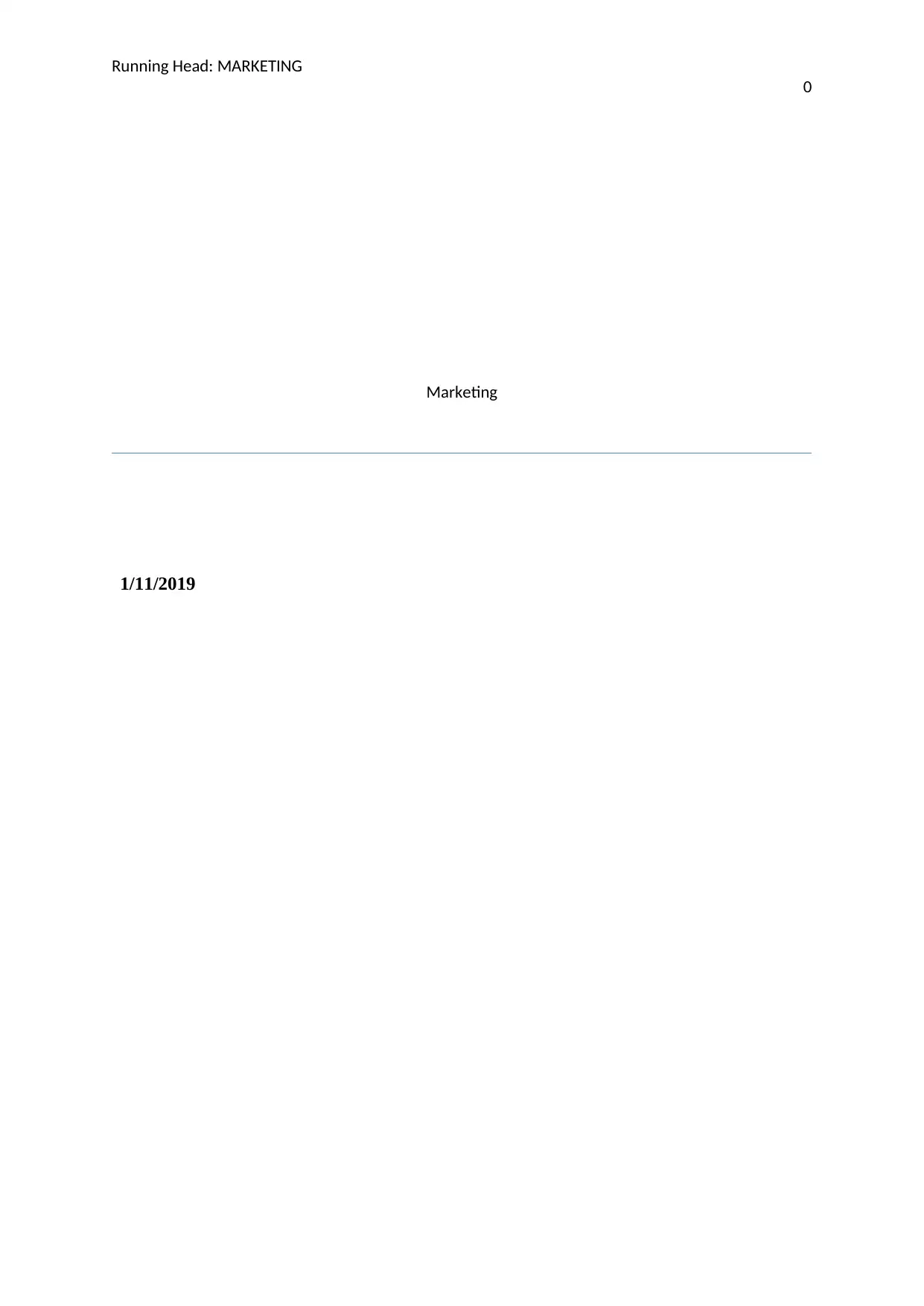
Running Head: MARKETING
0
Marketing
1/11/2019
0
Marketing
1/11/2019
Paraphrase This Document
Need a fresh take? Get an instant paraphrase of this document with our AI Paraphraser
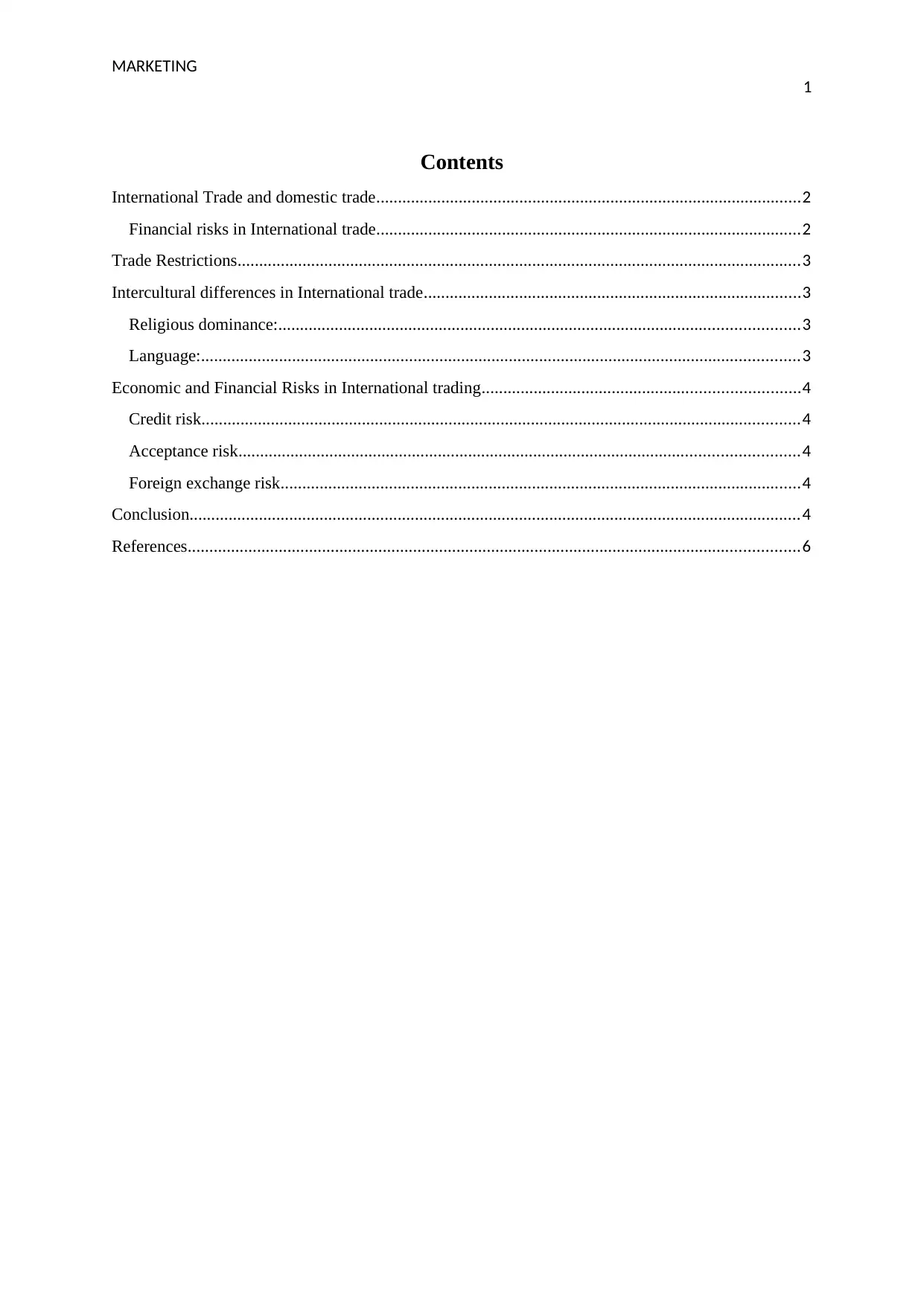
MARKETING
1
Contents
International Trade and domestic trade..................................................................................................2
Financial risks in International trade..................................................................................................2
Trade Restrictions..................................................................................................................................3
Intercultural differences in International trade.......................................................................................3
Religious dominance:........................................................................................................................3
Language:..........................................................................................................................................3
Economic and Financial Risks in International trading.........................................................................4
Credit risk..........................................................................................................................................4
Acceptance risk.................................................................................................................................4
Foreign exchange risk........................................................................................................................4
Conclusion.............................................................................................................................................4
References.............................................................................................................................................6
1
Contents
International Trade and domestic trade..................................................................................................2
Financial risks in International trade..................................................................................................2
Trade Restrictions..................................................................................................................................3
Intercultural differences in International trade.......................................................................................3
Religious dominance:........................................................................................................................3
Language:..........................................................................................................................................3
Economic and Financial Risks in International trading.........................................................................4
Credit risk..........................................................................................................................................4
Acceptance risk.................................................................................................................................4
Foreign exchange risk........................................................................................................................4
Conclusion.............................................................................................................................................4
References.............................................................................................................................................6
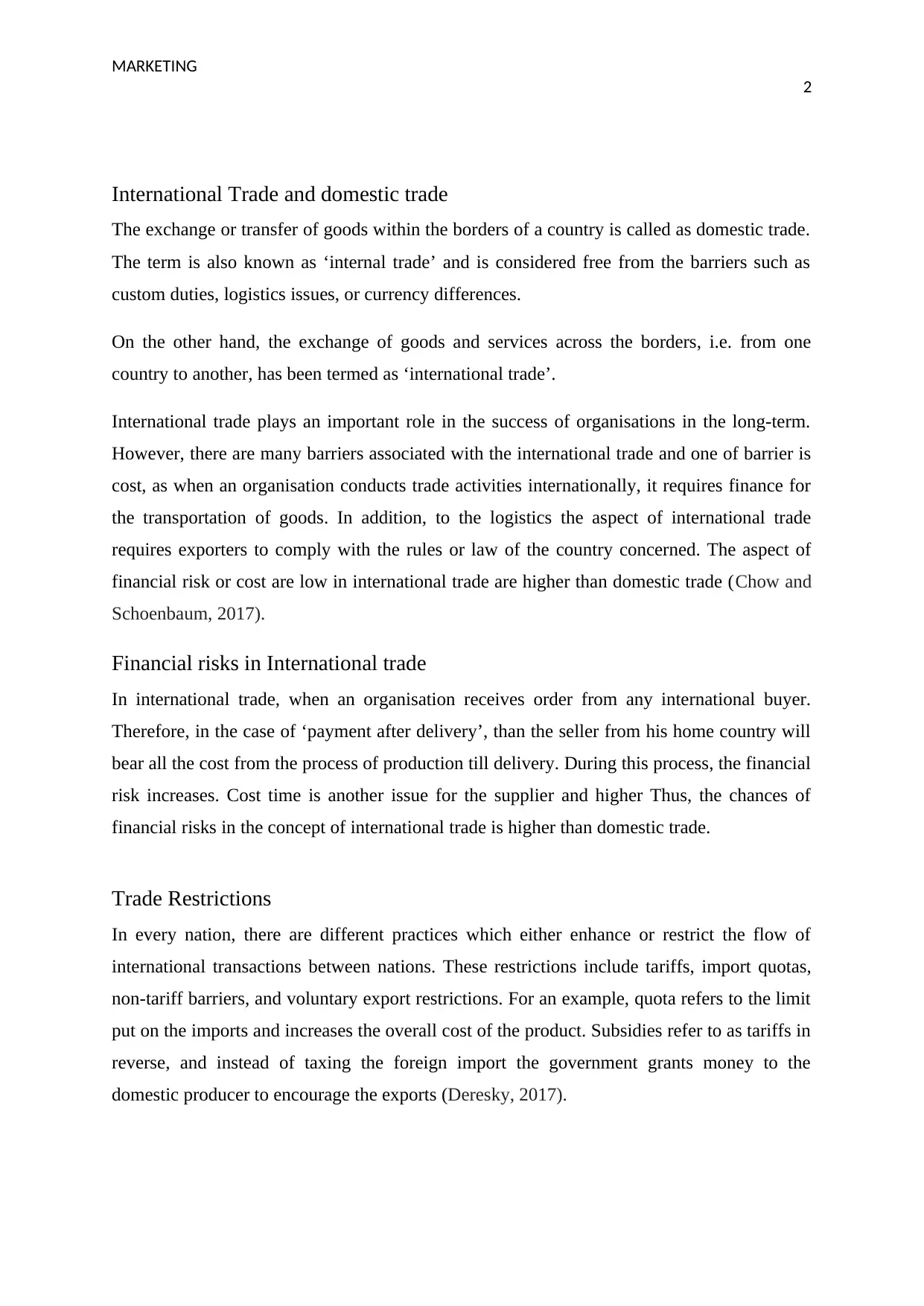
MARKETING
2
International Trade and domestic trade
The exchange or transfer of goods within the borders of a country is called as domestic trade.
The term is also known as ‘internal trade’ and is considered free from the barriers such as
custom duties, logistics issues, or currency differences.
On the other hand, the exchange of goods and services across the borders, i.e. from one
country to another, has been termed as ‘international trade’.
International trade plays an important role in the success of organisations in the long-term.
However, there are many barriers associated with the international trade and one of barrier is
cost, as when an organisation conducts trade activities internationally, it requires finance for
the transportation of goods. In addition, to the logistics the aspect of international trade
requires exporters to comply with the rules or law of the country concerned. The aspect of
financial risk or cost are low in international trade are higher than domestic trade (Chow and
Schoenbaum, 2017).
Financial risks in International trade
In international trade, when an organisation receives order from any international buyer.
Therefore, in the case of ‘payment after delivery’, than the seller from his home country will
bear all the cost from the process of production till delivery. During this process, the financial
risk increases. Cost time is another issue for the supplier and higher Thus, the chances of
financial risks in the concept of international trade is higher than domestic trade.
Trade Restrictions
In every nation, there are different practices which either enhance or restrict the flow of
international transactions between nations. These restrictions include tariffs, import quotas,
non-tariff barriers, and voluntary export restrictions. For an example, quota refers to the limit
put on the imports and increases the overall cost of the product. Subsidies refer to as tariffs in
reverse, and instead of taxing the foreign import the government grants money to the
domestic producer to encourage the exports (Deresky, 2017).
2
International Trade and domestic trade
The exchange or transfer of goods within the borders of a country is called as domestic trade.
The term is also known as ‘internal trade’ and is considered free from the barriers such as
custom duties, logistics issues, or currency differences.
On the other hand, the exchange of goods and services across the borders, i.e. from one
country to another, has been termed as ‘international trade’.
International trade plays an important role in the success of organisations in the long-term.
However, there are many barriers associated with the international trade and one of barrier is
cost, as when an organisation conducts trade activities internationally, it requires finance for
the transportation of goods. In addition, to the logistics the aspect of international trade
requires exporters to comply with the rules or law of the country concerned. The aspect of
financial risk or cost are low in international trade are higher than domestic trade (Chow and
Schoenbaum, 2017).
Financial risks in International trade
In international trade, when an organisation receives order from any international buyer.
Therefore, in the case of ‘payment after delivery’, than the seller from his home country will
bear all the cost from the process of production till delivery. During this process, the financial
risk increases. Cost time is another issue for the supplier and higher Thus, the chances of
financial risks in the concept of international trade is higher than domestic trade.
Trade Restrictions
In every nation, there are different practices which either enhance or restrict the flow of
international transactions between nations. These restrictions include tariffs, import quotas,
non-tariff barriers, and voluntary export restrictions. For an example, quota refers to the limit
put on the imports and increases the overall cost of the product. Subsidies refer to as tariffs in
reverse, and instead of taxing the foreign import the government grants money to the
domestic producer to encourage the exports (Deresky, 2017).
⊘ This is a preview!⊘
Do you want full access?
Subscribe today to unlock all pages.

Trusted by 1+ million students worldwide
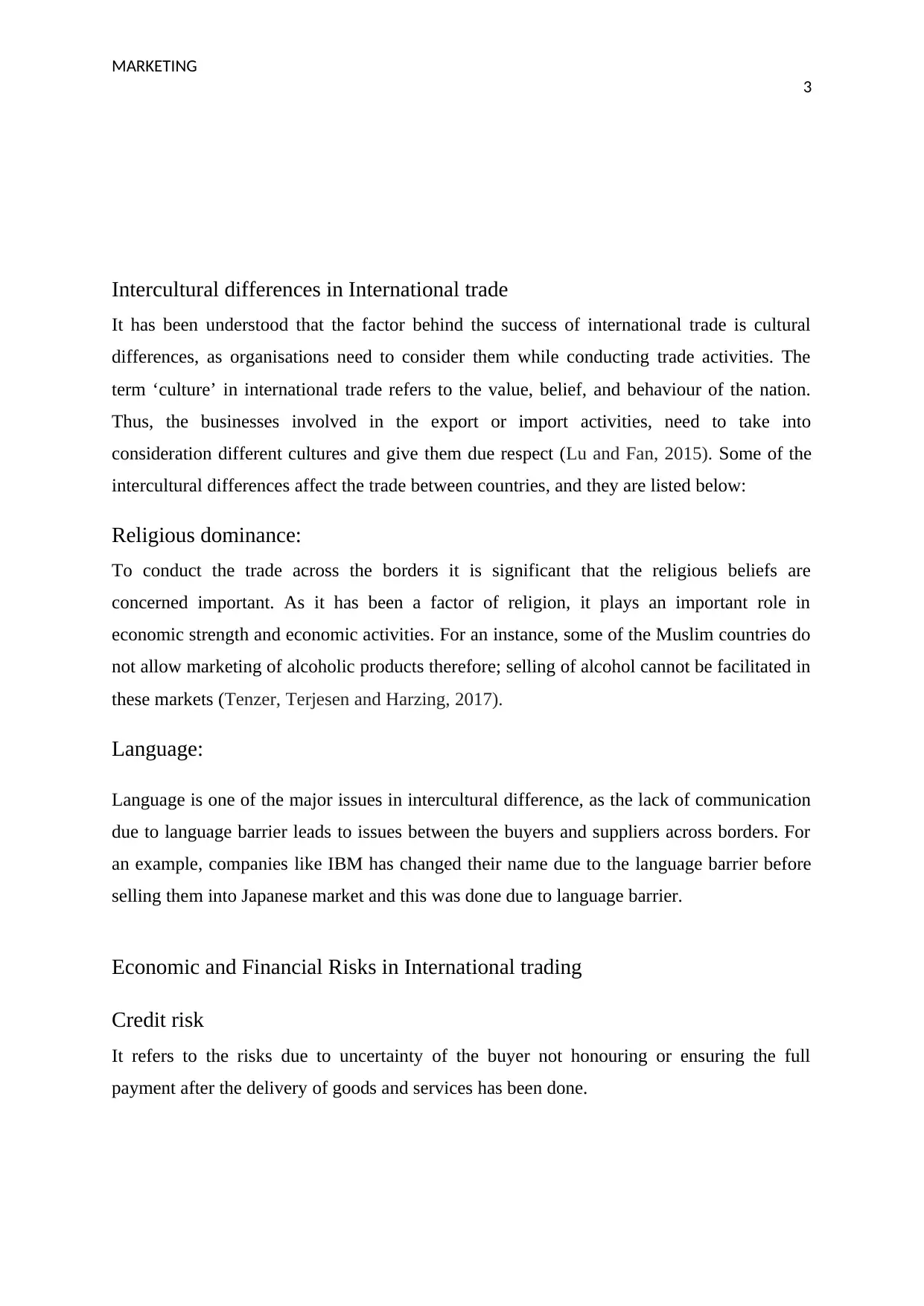
MARKETING
3
Intercultural differences in International trade
It has been understood that the factor behind the success of international trade is cultural
differences, as organisations need to consider them while conducting trade activities. The
term ‘culture’ in international trade refers to the value, belief, and behaviour of the nation.
Thus, the businesses involved in the export or import activities, need to take into
consideration different cultures and give them due respect (Lu and Fan, 2015). Some of the
intercultural differences affect the trade between countries, and they are listed below:
Religious dominance:
To conduct the trade across the borders it is significant that the religious beliefs are
concerned important. As it has been a factor of religion, it plays an important role in
economic strength and economic activities. For an instance, some of the Muslim countries do
not allow marketing of alcoholic products therefore; selling of alcohol cannot be facilitated in
these markets (Tenzer, Terjesen and Harzing, 2017).
Language:
Language is one of the major issues in intercultural difference, as the lack of communication
due to language barrier leads to issues between the buyers and suppliers across borders. For
an example, companies like IBM has changed their name due to the language barrier before
selling them into Japanese market and this was done due to language barrier.
Economic and Financial Risks in International trading
Credit risk
It refers to the risks due to uncertainty of the buyer not honouring or ensuring the full
payment after the delivery of goods and services has been done.
3
Intercultural differences in International trade
It has been understood that the factor behind the success of international trade is cultural
differences, as organisations need to consider them while conducting trade activities. The
term ‘culture’ in international trade refers to the value, belief, and behaviour of the nation.
Thus, the businesses involved in the export or import activities, need to take into
consideration different cultures and give them due respect (Lu and Fan, 2015). Some of the
intercultural differences affect the trade between countries, and they are listed below:
Religious dominance:
To conduct the trade across the borders it is significant that the religious beliefs are
concerned important. As it has been a factor of religion, it plays an important role in
economic strength and economic activities. For an instance, some of the Muslim countries do
not allow marketing of alcoholic products therefore; selling of alcohol cannot be facilitated in
these markets (Tenzer, Terjesen and Harzing, 2017).
Language:
Language is one of the major issues in intercultural difference, as the lack of communication
due to language barrier leads to issues between the buyers and suppliers across borders. For
an example, companies like IBM has changed their name due to the language barrier before
selling them into Japanese market and this was done due to language barrier.
Economic and Financial Risks in International trading
Credit risk
It refers to the risks due to uncertainty of the buyer not honouring or ensuring the full
payment after the delivery of goods and services has been done.
Paraphrase This Document
Need a fresh take? Get an instant paraphrase of this document with our AI Paraphraser
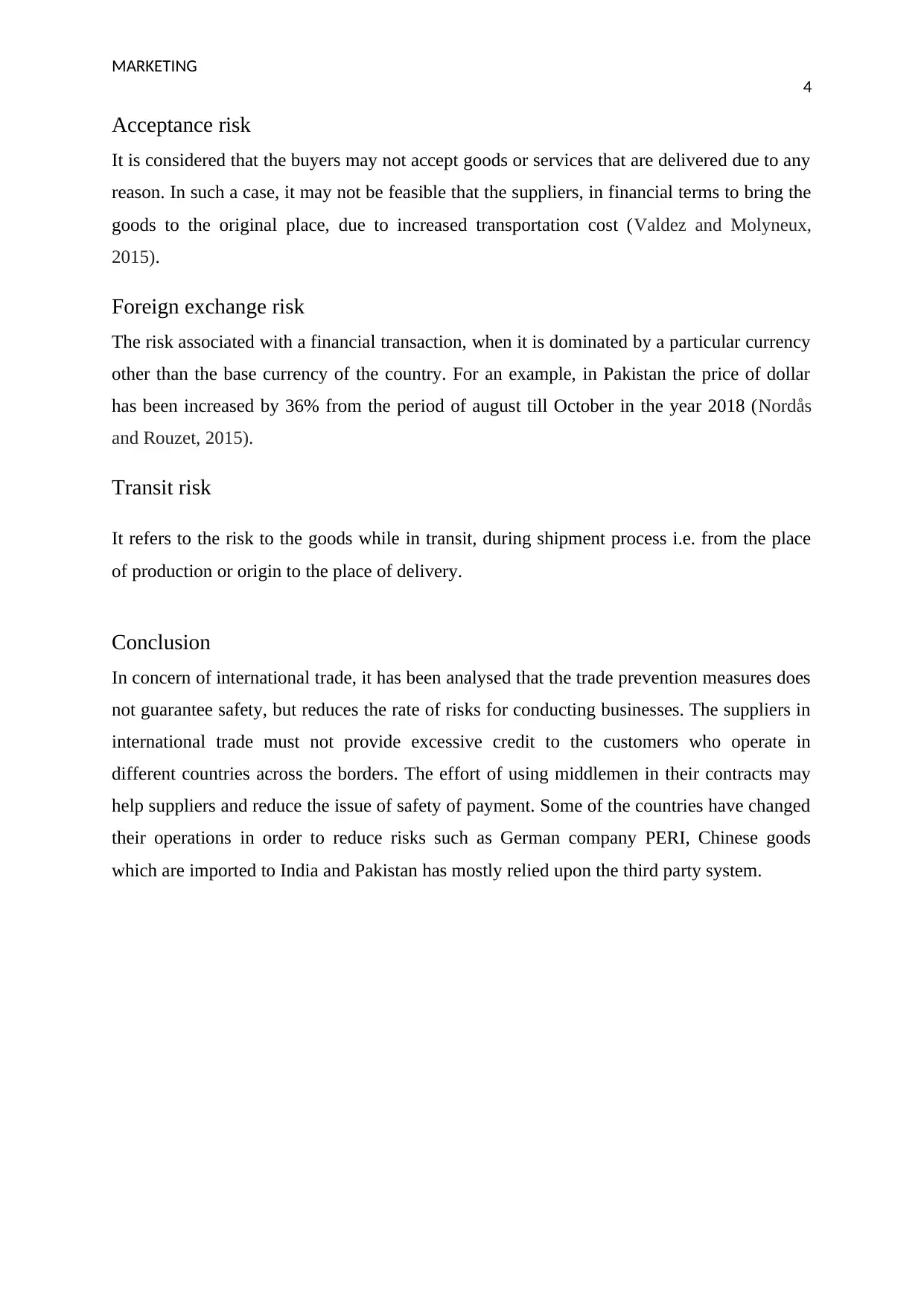
MARKETING
4
Acceptance risk
It is considered that the buyers may not accept goods or services that are delivered due to any
reason. In such a case, it may not be feasible that the suppliers, in financial terms to bring the
goods to the original place, due to increased transportation cost (Valdez and Molyneux,
2015).
Foreign exchange risk
The risk associated with a financial transaction, when it is dominated by a particular currency
other than the base currency of the country. For an example, in Pakistan the price of dollar
has been increased by 36% from the period of august till October in the year 2018 (Nordås
and Rouzet, 2015).
Transit risk
It refers to the risk to the goods while in transit, during shipment process i.e. from the place
of production or origin to the place of delivery.
Conclusion
In concern of international trade, it has been analysed that the trade prevention measures does
not guarantee safety, but reduces the rate of risks for conducting businesses. The suppliers in
international trade must not provide excessive credit to the customers who operate in
different countries across the borders. The effort of using middlemen in their contracts may
help suppliers and reduce the issue of safety of payment. Some of the countries have changed
their operations in order to reduce risks such as German company PERI, Chinese goods
which are imported to India and Pakistan has mostly relied upon the third party system.
4
Acceptance risk
It is considered that the buyers may not accept goods or services that are delivered due to any
reason. In such a case, it may not be feasible that the suppliers, in financial terms to bring the
goods to the original place, due to increased transportation cost (Valdez and Molyneux,
2015).
Foreign exchange risk
The risk associated with a financial transaction, when it is dominated by a particular currency
other than the base currency of the country. For an example, in Pakistan the price of dollar
has been increased by 36% from the period of august till October in the year 2018 (Nordås
and Rouzet, 2015).
Transit risk
It refers to the risk to the goods while in transit, during shipment process i.e. from the place
of production or origin to the place of delivery.
Conclusion
In concern of international trade, it has been analysed that the trade prevention measures does
not guarantee safety, but reduces the rate of risks for conducting businesses. The suppliers in
international trade must not provide excessive credit to the customers who operate in
different countries across the borders. The effort of using middlemen in their contracts may
help suppliers and reduce the issue of safety of payment. Some of the countries have changed
their operations in order to reduce risks such as German company PERI, Chinese goods
which are imported to India and Pakistan has mostly relied upon the third party system.

MARKETING
5
5
⊘ This is a preview!⊘
Do you want full access?
Subscribe today to unlock all pages.

Trusted by 1+ million students worldwide
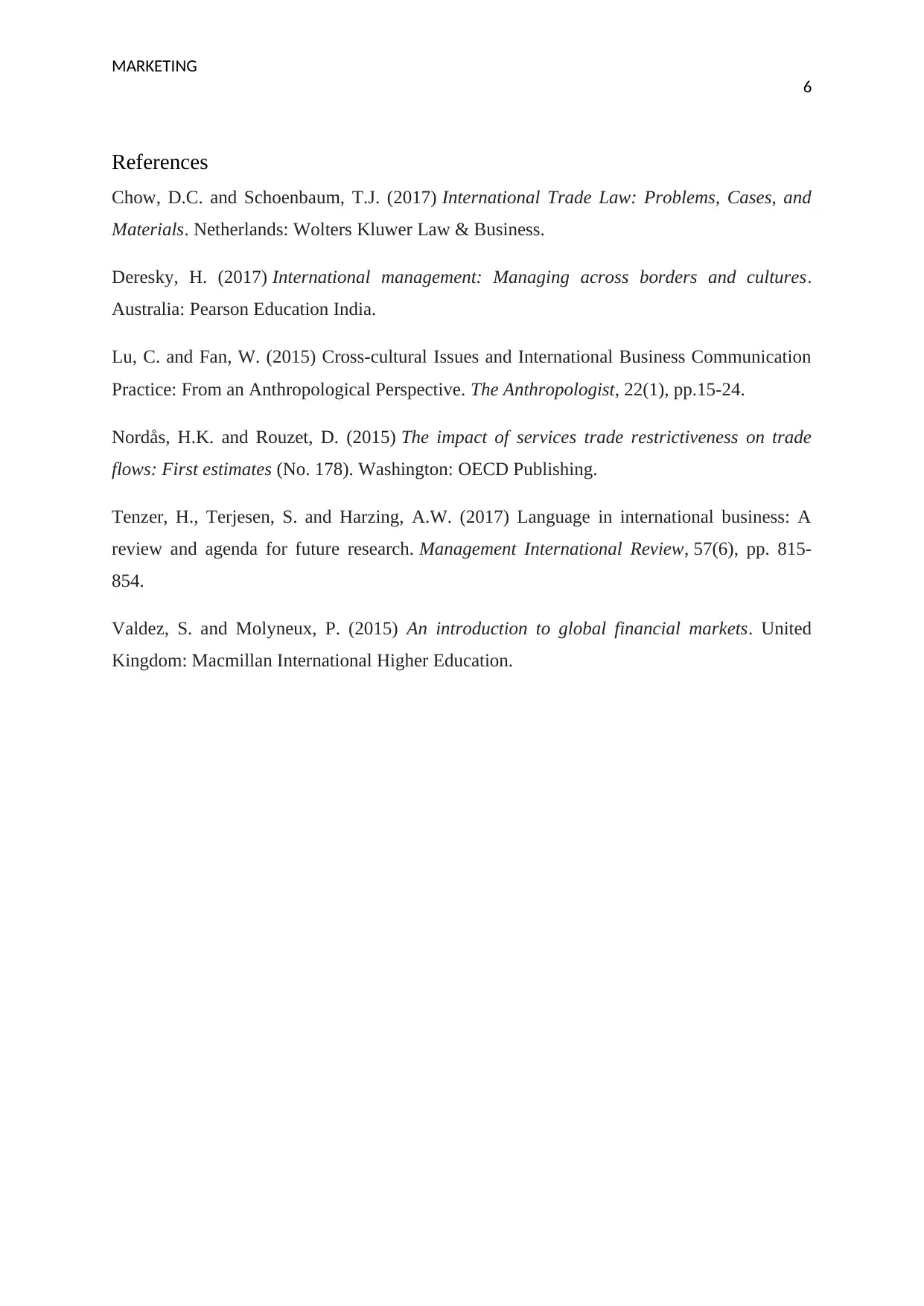
MARKETING
6
References
Chow, D.C. and Schoenbaum, T.J. (2017) International Trade Law: Problems, Cases, and
Materials. Netherlands: Wolters Kluwer Law & Business.
Deresky, H. (2017) International management: Managing across borders and cultures.
Australia: Pearson Education India.
Lu, C. and Fan, W. (2015) Cross-cultural Issues and International Business Communication
Practice: From an Anthropological Perspective. The Anthropologist, 22(1), pp.15-24.
Nordås, H.K. and Rouzet, D. (2015) The impact of services trade restrictiveness on trade
flows: First estimates (No. 178). Washington: OECD Publishing.
Tenzer, H., Terjesen, S. and Harzing, A.W. (2017) Language in international business: A
review and agenda for future research. Management International Review, 57(6), pp. 815-
854.
Valdez, S. and Molyneux, P. (2015) An introduction to global financial markets. United
Kingdom: Macmillan International Higher Education.
6
References
Chow, D.C. and Schoenbaum, T.J. (2017) International Trade Law: Problems, Cases, and
Materials. Netherlands: Wolters Kluwer Law & Business.
Deresky, H. (2017) International management: Managing across borders and cultures.
Australia: Pearson Education India.
Lu, C. and Fan, W. (2015) Cross-cultural Issues and International Business Communication
Practice: From an Anthropological Perspective. The Anthropologist, 22(1), pp.15-24.
Nordås, H.K. and Rouzet, D. (2015) The impact of services trade restrictiveness on trade
flows: First estimates (No. 178). Washington: OECD Publishing.
Tenzer, H., Terjesen, S. and Harzing, A.W. (2017) Language in international business: A
review and agenda for future research. Management International Review, 57(6), pp. 815-
854.
Valdez, S. and Molyneux, P. (2015) An introduction to global financial markets. United
Kingdom: Macmillan International Higher Education.
1 out of 7
Related Documents
Your All-in-One AI-Powered Toolkit for Academic Success.
+13062052269
info@desklib.com
Available 24*7 on WhatsApp / Email
![[object Object]](/_next/static/media/star-bottom.7253800d.svg)
Unlock your academic potential
Copyright © 2020–2025 A2Z Services. All Rights Reserved. Developed and managed by ZUCOL.




